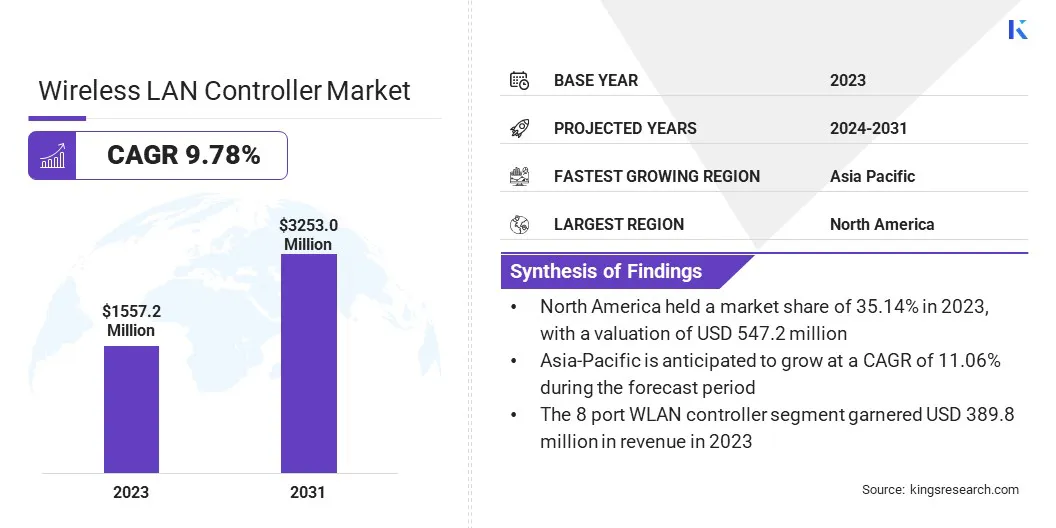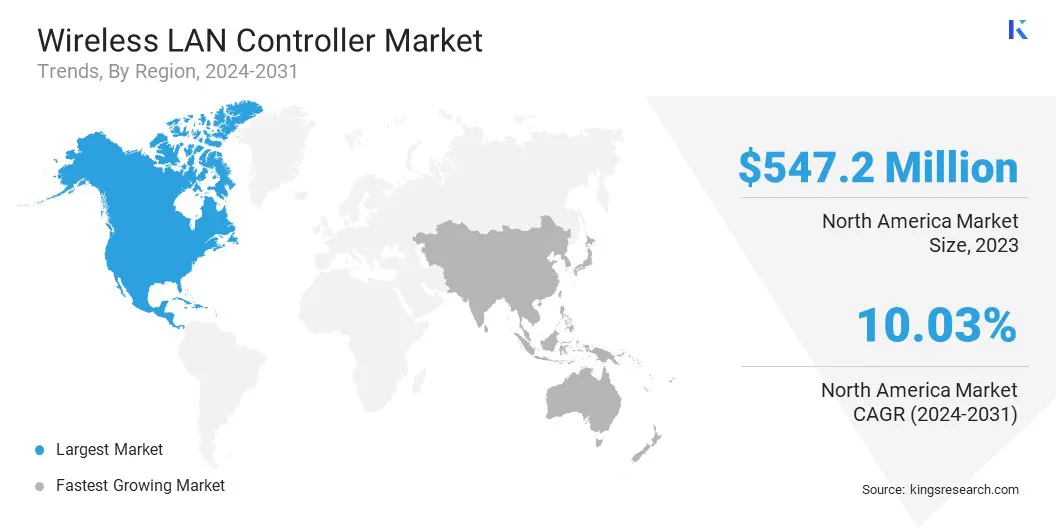Wireless LAN Controller Market Size
The global Wireless LAN Controller Market size was valued at USD 1,557.2 million in 2023 and is projected to grow from USD 1,692.4 million in 2024 to USD 3,253.0 million by 2031, exhibiting a CAGR of 9.78% during the forecast period. The expansion of the market is driven by the increasing demand for seamless connectivity, the proliferation of IoT devices, advancements in wireless technology, and the growing need for robust network management and security.
In the scope of work, the report includes solutions offered by companies such as Avaya LLC, Belden Inc., Cisco Systems, Inc., Fortinet, Inc., Hewlett Packard Enterprise Development LP, Huawei Technologies Co., Ltd., Juniper Networks, Inc., Zyxel, NETGEAR, SAMSUNG ELECTRONICS AMERICA., and others.
The growth of the market is primarily fueled by the increasing demand for seamless connectivity and the growing adoption of wireless devices in both residential and commercial sectors. The proliferation of IoT (Internet of Things) devices and the expansion of smart cities necessitate robust network infrastructure, which is propelling market growth.
- For instance, in April 2024, Ceva, Inc. launched the Ceva-Waves Links family of multi-protocol wireless platform IPs to support the latest wireless standards and meet the increasing demand for connectivity-rich chips across various markets, including IoT, automotive, industrial, and personal computing. The first IP in this family, Ceva-Waves Links100, integrates Bluetooth 5.4, Wi-Fi 6, and IEEE 802.15.4 communications subsystems tailored for IoT applications.
Additionally, the growing shift toward remote work and digital learning due to global events such as the COVID-19 pandemic has amplified the need for reliable and efficient wireless LAN solutions. Advances in wireless technology, such as Wi-Fi 6 and 5G integration, are key factors enhancing the performance and increasing the adoption of wireless LAN controllers across various industries.
The wireless LAN controller industry is witnessing significant growth due to the rising demand for high-speed internet and the increasing number of connected devices. Key market players are focusing on innovations and strategic partnerships to cater to diverse end-user needs.
North America holds a prominent share of the market, propelled by advanced technological infrastructure and early adoption of new technologies. However, the Asia-Pacific region is expected to exhibit the highest growth rate, attributed to rapid urbanization and industrialization.
The market is highly competitive, with companies investing heavily in research and development to offer enhanced features and improved security measures for wireless networks.
A wireless LAN controller is a network device used for managing wireless access points in large-scale environments, thereby ensuring optimal performance and security. It centralizes the management of wireless networks, providing administrators with the ability to configure, manage, and monitor multiple access points from a single interface.
These controllers are essential in enterprise settings, educational institutions, healthcare facilities, and public venues, where robust and reliable wireless connectivity is crucial.
They play a vital role in maintaining network efficiency, load balancing, and seamless roaming for users. The market encompasses various products and solutions designed specifically to enhance wireless network performance, scalability, and security.

Analyst’s Review
Manufacturers in the wireless LAN controller market are prioritizing innovation and strategic partnerships to maintain competitiveness. Companies are introducing new products that incorporate advanced features such as AI-driven analytics and Wi-Fi 6 compatibility.
- For instance, in November 2023, MediaTek introduced its new Filogic 360 and Filogic 860 solutions, expanding its comprehensive Wi-Fi 7 portfolio. The Filogic 860, which combined a Wi-Fi 7 dual-band access point with an advanced network processor, targeted enterprise and retail applications. The Filogic 360, a single-chip solution with Wi-Fi 7 2x2 and dual Bluetooth 5.4 radios, designed to enhance connectivity for consumer electronics. Both products featured advanced technologies to boost performance and reliability.
These efforts aim to enhance network performance, security, and user experience. There is a notable shift toward integrated solutions, which streamline network management for businesses. It is recommended that manufacturers continue to focus on developing scalable and secure solutions to meet the growing demands of the rapidly transforming industry.
Additionally, investing in cybersecurity measures and providing comprehensive customer support are likely to be crucial for maintaining market leadership and addressing evolving network challenges.
Wireless LAN Controller Market Growth Factors
The growing adoption of IoT devices is propelling the expansion of the market. As the number of connected devices continues to rise, ranging from smart home gadgets to industrial sensors, the need for efficient network management is increasing.
Wireless LAN controllers are crucial in handling the surge of data traffic and ensuring seamless connectivity. They offer centralized control, enabling businesses to manage multiple access points and maintain network stability.
Moreover, the rise in smart cities and the expansion of digital infrastructure are contributing to this trend, as these initiatives require robust and scalable wireless networks. This is leading to increased demand for advanced wireless LAN controllers.
A significant challenge impeding the development of the wireless LAN controller market is the increasing threat of cybersecurity risks. As wireless networks continue to expand, they become more vulnerable to attacks, which poses a risk of data breaches and network disruptions. To overcome this challenge, manufacturers are integrating advanced security features into wireless LAN controllers.
This includes encryption protocols, intrusion detection systems, and regular firmware updates to protect against emerging threats. Additionally, businesses are investing heavily in comprehensive network security strategies and training staff on best practices.
By integrating robust security measures with ongoing education, industry players are effectively mitigating risks and ensuring the safe operation of wireless networks.
Wireless LAN Controller Market Trends
The market is undergoing a gradual transformation due to the integration of artificial intelligence (AI) and machine learning (ML) technologies. Companies are leveraging AI and ML to enhance network management and performance. These technologies facilitate predictive maintenance, automated troubleshooting, and the dynamic optimization of network resources.
AI-driven analytics provide deeper insights into network usage patterns, thereby helping administrators make informed decisions. This trend is improving the efficiency and reliability of wireless networks, reducing downtime, and enhancing user experiences. As AI and ML continue to evolve, their role in reshaping the landscape of wireless LAN controllers is becoming increasingly pivotal.
The adoption of Wi-Fi 6 technology is another significant trend impacting the wireless LAN controller market. Wi-Fi 6, offers higher data transfer speeds, increased capacity, and improved performance in dense environments. It is designed to handle the growing number of connected devices, providing improved efficiency and reduced latency.
Businesses and institutions are upgrading their wireless infrastructure to leverage the advantages of Wi-Fi 6 benefits, thereby ensuring the longevity and reliability of their networks.
This trend is boosting the demand for compatible wireless LAN controllers that are able to support the advanced features of Wi-Fi 6, thereby enhancing overall network performance and user satisfaction.
Segmentation Analysis
The global market is segmented based on port type, type, organization size, end use, and geography.
By Port Type
Based on port type, the market is categorized into 2 port WLAN controller, 4 port WLAN controller, 6 port WLAN controller, 8 port WLAN controller, 16 port WLAN controller, and others.
The 8 port WLAN controller segment led the wireless LAN controller market in 2023, reaching a valuation of USD 389.8 million. This notable growth is largely attributed to its optimal balance between cost and performance, making it ideal for medium to large enterprises.wireless LAN controller
These controllers offer the flexibility to manage a substantial number of access points without the higher costs associated with larger port controllers. Their scalability allows businesses to effectively manage increasing network demands as they expand. Additionally, the 8 port WLAN controllers provide robust performance and enhanced security features, which are crucial for enterprises aiming to ensure reliable and secure wireless networks.
By Type
Based on type, the market is classified into standalone and integrated. The integrated segment is poised to witness significant growth at a CAGR of 10.33% through the forecast period (2024-2031), primarily due to its ability to combine multiple network functions into a single device.
This integration reduces the complexity and costs associated with deploying and managing separate devices. Integrated controllers offer streamlined management, easier scalability, and improved network performance. Their compatibility with various network components enhances overall system efficiency.
The projected growth highlights the increasing preference for integrated solutions, as businesses increasingly seek to simplify network management and achieve higher operational efficiencies. This trend reflects the growing demand for cohesive and cost-effective networking solutions, which is supporting the growth of the segment.
By Enterprise Size
Based on enterprise size, the market is segmented into large enterprise and SMEs. The large enterprise segment secured the largest wireless LAN controller market share of 64.87% in 2023. This dominance is reinforced by its substantial network infrastructure needs and the increased adoption of advanced wireless solutions.
Large enterprises require robust and scalable WLAN controllers to manage extensive networks and support a vast number of connected devices. Their significant financial resources allow them to invest in high-performance network solutions that ensure reliable connectivity and enhanced security. Large enterprises are continuously expanding their digital infrastructure, thereby highlighting the need for advanced WLAN controllers to maintain seamless and efficient network operations.
Wireless LAN Controller Market Regional Analysis
Based on region, the global market is classified into North America, Europe, Asia-Pacific, MEA, and Latin America.

North America wireless LAN controller market held a substantial share of around 35.14% in 2023, with a valuation of USD 547.2 million. This notable expansion is bolstered by the region's advanced technological infrastructure and high adoption rate of wireless technologies. The presence of leading market players and continuous innovation are further propelling this growth.
North America's focus on digital transformation across various industries, including healthcare, education, and retail, is increasing the demand for robust wireless network solutions. Additionally, significant investments in research and development and the early adoption of cutting-edge technologies, such as Wi-Fi 6 and IoT, are contributing to the expansion of the regional market.
Asia-Pacific is poised to experience significant growth at a CAGR of 11.06% over the forecast period, primarily fostered by rapid urbanization and industrialization. The region is witnessing a surge in demand for advanced networking solutions to support the increasing number of connected devices and smart city initiatives.
Both governments and enterprises are investing heavily in digital infrastructure, which is fueling the widespread adoption of wireless LAN controllers. Additionally, the expanding IT and telecommunications sectors in countries such as China, India, and Japan are boosting regional market growth.
Competitive Landscape
The global wireless LAN controller market report will provide valuable insight with an emphasis on the fragmented nature of the industry. Prominent players are focusing on several key business strategies such as partnerships, mergers and acquisitions, product innovations, and joint ventures to expand their product portfolio and increase their market shares across different regions.
Expansion & investments are the major strategic initiatives adopted by companies in this sector. Industry players are investing extensively in R&D activities, building new manufacturing facilities, and supply chain optimization.
List of Key Companies in Wireless LAN Controller Market
The global wireless LAN controller market is segmented as:
By Port Type
- 2 port WLAN Controller
- 4 port WLAN Controller
- 6 port WLAN Controller
- 8 port WLAN Controller
- 16 port WLAN Controller
- Others
By Type
By Enterprise Size
By End Use
- IT & Telecom
- BFSI
- Healthcare
- Retail
- Manufacturing
- Others
By Region
- North America
- Europe
- France
- U.K.
- Spain
- Germany
- Italy
- Russia
- Rest of Europe
- Asia-Pacific
- China
- Japan
- India
- South Korea
- Rest of Asia-Pacific
- Middle East & Africa
- GCC
- North Africa
- South Africa
- Rest of Middle East & Africa
- Latin America
- Brazil
- Argentina
- Rest of Latin America


